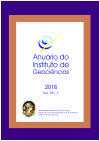Coastal Sedimentation in a Tropical Barrier-Island System During the Past Century in Sepetiba Bay, Brazil
DOI:
https://doi.org/10.11137/2016_2_05_14Keywords:
210Pb geochronology, Sedimentation, Sepetiba Bay, Seismic stratigraphyAbstract
The nature of sedimentation and sediment accumulation rates in Sepetiba Bay, Brazil were interpreted from grainsize patterns, natural radiochemical distributions and seismic stratigraphy. The grain-size analyses showed progressive upward fining of sediment in cores, and a higher percentage of clay in surficial deposits in 1996 than observed during a previous spatial survey in the 1970s. Based on 210Pb geochronology, accumulation rates range from 0.37 cm yr-1 to 2.0 cm yr-1 for the last hundred years. In contrast, seismic stratigraphy indicates a range from 0.01 to 0.17 cm yr-1 over the last 7000 years. Particularly high accumulation rates are found in the northeast part of the bay, and, as a consequence of these high rates, the shoreline in the northern part of the bay prograded approximately 400 m in the last 100 years. An apparent increase in accumulation rates and a tendency for deposits to fine upward over the last ~ 100 years are attributed to human disturbance and soil erosion inland, which have been accelerated with economic development since the late 1970s.Downloads
Published
2016-06-23
Issue
Section
não definida
License
This journal is licensed under a Creative Commons — Attribution 4.0 International — CC BY 4.0, which permits use, distribution and reproduction in any medium, provided the original work is properly cited.
















 Except where otherwise noted, content on this site is licensed under a license
Except where otherwise noted, content on this site is licensed under a license 